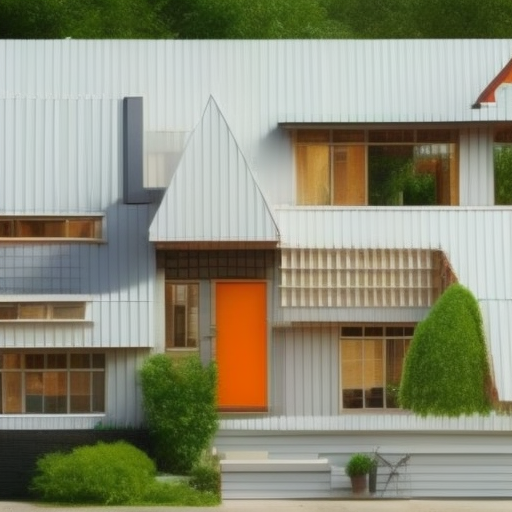What shape is the most efficient when designing your new home? This is an important decision – one that will affect your home’s energy efficiency and environmental impact in the long-term. From traditional houses to modern, box-shaped designs and other intricate styles, it can be difficult to determine which house shape is most efficient. In this article, we will discuss the different factors to consider when choosing the most efficient home shape.
Understanding House Shape
Have you ever wondered why some houses look weirdly shaped, like they were designed by an alien? Or why certain house shapes are more common in certain regions? Well, my friend, it all boils down to efficiency.
Firstly, let’s talk about the basics – a rectangular-shaped house is the most efficient shape. It’s not only easier to build and costs less, but it also maximizes the usable floor area. This is why you see most houses in suburban areas looking rectangular or even square. However, don’t be fooled by this traditional shape – there are a myriad of variables to consider when designing a house that can significantly affect its efficiency. For instance, the direction the house faces, insulation, and your local climate can all impact energy usage and efficiency.
- In colder climates, houses tend to have a triangular roof to prevent snow buildup and allow for better ventilation.
- In areas prone to high winds, a hexagonal shape is preferred as it can offer better structural stability and reduces wind resistance.
- For regions with abundant sunshine and high temperatures, a dome shape can reduce energy usage by letting natural light and air circulate better.
Therefore, understanding your region’s climate and environment can help determine the most efficient shape for your house. But don’t forget aesthetics – at the end of the day, it’s important to find a balance between efficiency and design to build a home that is functional, comfortable and represents your style.
Factors Influencing Efficiency
There are many factors that can influence the efficiency of a house. One of the most important of these is the shape of the house itself. While there are many different shapes that a house can take, some are more efficient than others. Factors such as insulation, orientation, and airflow all play a critical role in how efficiently a house operates.
For example, a house that is designed with a lot of natural light will require less artificial lighting and, therefore, less energy to keep it illuminated. Similarly, a home with good insulation will retain heat better, reducing the need for heating in the winter. Additionally, a well-oriented house will take advantage of passive solar heating, keeping it warmer in the winter and cooler in the summer without the need for additional heating or air conditioning. In combination, these factors can significantly reduce energy consumption and lower utility bills.
Some other key factors that can influence the efficiency of a house include the type of roofing, the use of energy-efficient appliances, and the incorporation of renewable energy sources like solar panels. Ultimately, the ideal house shape will depend on a variety of factors, including the climate in which it is built, the available budget, and the specific needs of the family living in it. When building or renovating a home, it’s important to carefully consider all of these factors in order to create the most efficient and cost-effective living space possible.
Design Considerations
When it comes to designing the most efficient house shape, there are a lot of factors to consider. One important consideration is the orientation of the house. A house that is oriented to take advantage of natural lighting and heating can significantly reduce energy costs. Designers must also consider the local climate and weather patterns. For example, a house in a hurricane-prone area should be built to withstand the high winds and possible storm surges.
Another important consideration is the type of materials used in construction. Using sustainable materials, such as bamboo or recycled materials, can reduce the environmental impact of construction. Additionally, incorporating energy-efficient appliances and systems, such as solar panels and smart thermostats, can further reduce energy consumption and costs. Of course, budget is also an important factor to consider, but with the right , even a modest budget can result in an efficient and comfortable home.
Conclusion
What’s the verdict then?
After discussing numerous house shapes, it’s safe to conclude that the most efficient house shape is the “A-frame” or “Triangle” shape. It has a unique design that enables it to withstand high winds and heavy snowfall.
But what makes the A-frame shape stand out is its energy efficiency. It has a small surface area and a steep pitched roof, which means it receives less solar radiation during summer, reducing its cooling needs, and more solar radiation during winter, saving on heating bills. Additionally, the shape is excellent for passive ventilation, allowing for natural air circulation, thus reducing air conditioning bills.
However, efficiency isn’t only a matter of the house shape but rather how you make use of the available space. You can have the most efficient house shape, but if you don’t optimize the interior space, you’ll still end up with a less efficient house.
The key takeaway?
- The “A-frame” or “Triangle” shape is the most efficient house shape due to its energy efficiency and unique design.
- Efficiency isn’t only a matter of the house shape, but how you optimize the interior space.
When it comes to efficiency, it really pays to think outside of the box. As the shapes of our homes continue to evolve, we can use a combination of thoughtful design and modern technology to ensure they stay efficient in the long run. This can result in a healthier and more sustainable home which both you and the environment can benefit from.